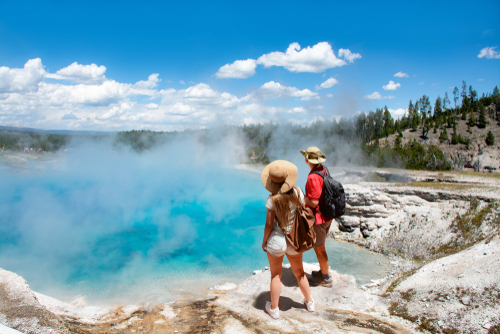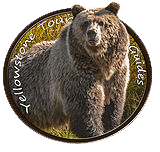With over 900 miles of trails and 300 backcountry campsites, Yellowstone National Park is a hiker’s dream. But before you start your journey, it’s important to know what precautions you should take. Weather, elevation, wildlife encounters, and the physiological effects of the park’s terrain can make a difference between a comfortable hike and a dangerous one, so our Yellowstone tour guides are here to help.
Precautions
Yellowstone is a magical place that boasts a wealth of natural beauty and a host of wildlife to watch. However, it’s important to be aware of some safety precautions you need to take when hiking in this national park. One of the most common safety concerns for hikers is that of wildlife. While many of these animals are docile and calm, others can become aggressive if they feel threatened. Bears are perhaps the most dangerous animal to watch for when in the park, but other animals like bison can be equally unpredictable. If you encounter a bison, give it space and wait for it to move away from you. Moose are another animal that should be kept on the lookout for, especially during rut season. These strong animals with large antlers can be quite aggressive, so if you see a moose, don’t try to walk around it or approach it.
What To Bring
If you’re planning on a single-day hiking trip in Yellowstone, here are a few essentials that you’ll want to bring with you. They’ll help you stay comfortable and happy on your adventure! First of all, you’ll want a backpack or day pack to carry all your gear. Whether you’re staying in a campground or tenting, you’ll need a bag that can hold everything you need and is comfortable to wear throughout the day. You’ll also need a few things to keep you safe, like sunscreen and bear spray. Sunscreen is especially important if you’re going to be hiking around high altitudes, where the UV rays can be intense. You’ll also need a hat to protect your head from the sun and wind. You can opt for a baseball cap or a hat that can be crushed and packed down, so it won’t take up too much space in your pack. Keeping your hands warm is also important, so be sure to bring insulated gloves or mittens.
Staying Safe
Hiking in Yellowstone is an excellent way to get up close and personal with nature, but there are a few things to look out for before you go. For one, bears can be a big threat to visitors, so be sure to lock up any food or plates you’ll be carrying. Another thing to keep in mind is that hiking off the trail is frowned upon, so you’ll want to stay on the designated pathways as much as possible. Straying can lead to a variety of negative consequences, such as damaging the ecosystem or harming wildlife. You should also plan to spend at least 3 days in Yellowstone to really see and do it all! That way you can fit in all the must-sees and still have time to hike some extra trails, too. Contact us to start planning your next adventure now!
Tips For Visiting Yellowstone National Park In The Spring
Yellowstone National Park is an incredible place to visit at any time of year, but springtime brings its own uniqueness. It’s full of new life and exciting wildlife, and it’s a great way to experience this incredible natural wonder!
1. Hike Early In The Morning
If you want to get the most out of your Yellowstone National Park experience, it’s important to hike early in the morning. This will give you plenty of time to enjoy the park and not be rushed. Hiking in Yellowstone is one of the best ways to see the parks natural wonders, and there are many great hikes to choose from. For those looking for a longer trek, the North Rim Trail is a great choice. It offers incredible views and is very accessible.
2. Be Prepared For The Weather
Spring is a great time to visit Yellowstone, because the parks roads are still open and wildlife is in full bloom. The number of visitors is still low, but you’ll have more chances to see wildlife than you would during the summer season. Yellowstone’s weather is unpredictable, so be prepared to pack warm clothing and rain gear. It can be cold at night in the park and icy during the day, especially if you’re hiking high in the mountains. The weather can also change drastically from day to day, so it’s best to keep an eye on the forecast before you set out each morning. April can be a transition month, with a lot of snow melting during the day and then refreezing at night, making icy conditions more common.
3. Don’t Be Afraid Of Bears
Spring is the best time to see grizzly and black bears, their cubs and young ones. This is also a great time to spot other wildlife like wolves and bison, as they resurface from their winter dens and shelters. Bears are usually curious about new things, so make some noise and yell, “Hey bear!” every once in a while. This will alert them that you are out and about, and they’ll be less likely to approach you. If you notice a bear, back away slowly. Keep your hands away from your neck and shoulders, and use a bear spray to deter any attacks. You can rent bear spray directly at Yellowstone national park.
4. Be Patient
If you are looking to get the most out of your Yellowstone National Park trip, you should be prepared to be patient. The park is one of the most popular destinations in the world, and it can be easy to become overwhelmed if you don’t know what to expect. While the summer season (June, July, and August) is by far the busiest, you can still see plenty of wildlife in the spring. Bears emerge from hibernation between March and April, migrating birds arrive just before May, and the elk rut begins mid-September.
5. Be Flexible
Spring in Yellowstone is a time of renewal, as animals escape the winter weather to find warmth and rebirth. It’s a great time to see bears, elk, and bison birthing calves, as well as emerging from Winter dens. One of the best ways to experience Yellowstone National Park is to be flexible. This will help you get the most out of your trip, and avoid frustrations such as traffic jams caused by wildlife or crowded parking lots. Be sure to plan ahead! After all, you won’t want to miss out on a geyser eruption or an unexpected wildlife encounter!
Yellowstone National Park is one of the most majestic areas of the country with some of the best Yellowstone tours. However, that magnificence comes with some unfamiliar dangers. Yellowstone is full of various forms of wildlife, including bears, bison, elk, and wolves.
Believe it or not, bison have caused injury to more people in the park than any of the other wildlife. Bison are considered the largest land mammal in North America. They are beautiful creatures, but they can be dangerous. In fact, bison can run roughly three times as fast as you, so taking precautions is always your best bet.
Don’t Approach Wildlife
Bison, as well as the other animals in Yellowstone National Park, are completely unpredictable and wild. While they may appear calm and approachable, they most certainly are not.
Keep Your Distance and Remain on Trails
It is recommended that you stay a minimum of 25 yards away from bison. As you are hiking in Yellowstone, make sure to stay on the trails. Avoid venturing off into the meadows, especially if you see bison nearby.
Avoid Feeding Wildlife
Wildlife can become dependent on human food. Unfortunately, when this happens, the animals become increasingly aggressive toward humans and must be put down. Therefore, you should never feed bison or other wildlife. At the same time, keep any food or strong-odored items well sealed when not in use.
Don’t Block Traffic and Stay in Your Vehicle
When viewing Yellowstone wildlife and scenery from the roads, make sure that you never block vehicle or wildlife traffic. Use the provided pullouts to watch Yellowstone wildlife and provide cars behind you the option to go around. If you encounter a wildlife traffic jam, stay n the vehicle. You should never pursue any animal in the park to obtain a picture.
Stay Safe in Yellowstone National Park
If you’re planning a trip to Yellowstone National Park in the near future, it is important that you understand how to not only protect yourself but the park and Yellowstone wildlife as well. Your safety cannot be guaranteed while within the national park, but following the rules and staying aware of your surroundings will help prevent common accidents and injuries. It will also keep the wildlife safe.
Aside from keeping the aforementioned Yellowstone wildlife safety rules in mind, consider opting for Yellowstone Tours which are offered by certified guides.

